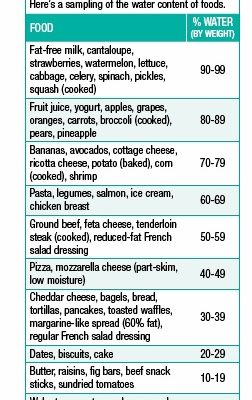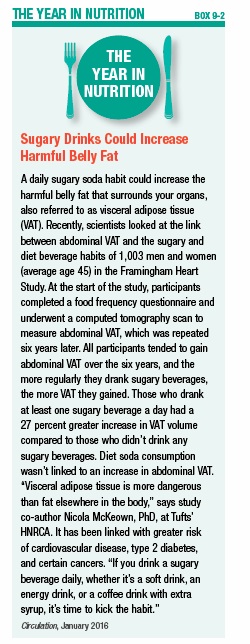9. Beverages: Staying Hydrated
A cool glass of water is calorie-free, readily available, and refreshing. Without water, you could live only a few days. Between 45 and 75 percent of a person’s body weight is water. Water is necessary for transporting nutrients, facilitating digestion, lubricating joints and body tissues, maintaining blood pressure and circulation, regulating body temperature (via sweating), and eliminating waste.
You’ve probably heard the rule of thumb that you need eight 8-ounce glasses of water a day. The basis for this recommendation is uncertain, and although this amount of water might be enough for some people, others may need a bit more. The Dietary Reference Intakes specify that the Adequate Intake level (which covers the needs of most people) for water is 12 cups or 95 ounces per day for women and 16 cups or 130 ounces per day for men. Your individual needs likely differ a bit from these broad guidelines, though. Older adults tend to have a reduced sense of thirst and lower fluid reserves in their body, and they may be taking medications such as diuretics that increase water loss, so they may need to pay more attention to their fluid intake.
Other than water, you can meet your fluid needs with milk, juice, tea, coffee, fruits, vegetables, and even cooked grains and meats (see Box 9-1, “Water Content of Foods and Beverages”). It’s estimated that people get 20 to 30 percent of their water from food, on average.
Shift to Healthier Beverages
Although all beverages count toward your fluid needs, all beverages aren’t equal. Sugar-sweetened beverages, such as sodas, energy drinks, and fruit drinks, and tea and coffee with added sugar have been linked to weight gain (see Box 9-2, “Sugary Drinks Could Increase Harmful Belly Fat,” on page 55), obesity, heart disease (including increased triglycerides), high blood pressure, insulin resistance, type 2 diabetes, gout, and a fatty liver. Sports drinks also contain added sugars and are usually unnecessary for the casual exerciser.
On average, beverages account for almost 20 percent of the calories people consume. In some beverages, such as soda, the calories come without any nutritional value, while milk and fruit and vegetable juices provide nutrients, such as calcium and potassium. Even unsweetened coffee and tea have antioxidant and other health benefits. Even though 100-percent fruit juices contain only natural fruit sugars, limit your consumption to 8 ounces or less per day since some studies have linked them with greater weight gain and type 2 diabetes. Furthermore, consuming liquid calories, such as from orange juice, may not provide as much satiety (sense of fullness) as consuming calories from solid foods, such as a whole orange.
Although you could replace sugar-sweetened beverages with artificially sweetened ones to save calories, some studies suggest that the intense sweetness of sugar substitutes may foster a greater preference for sweets and increase appetite. A recent study suggests diet soda drinkers are more prone to indulging in nutrient-poor treats, which is counterproductive to good health (see Box 9-3, “Diet Soda and Coffee Drinkers Eat More Unhealthy Treats,” on page 56). Preliminary animal studies also suggest that artificial sweeteners might change gut bacteria in ways that promote obesity and type 2 diabetes.
Coffee and Tea
Coffee and tea are two of the most consumed beverages around the world. Both are frequent subjects of research studies, some of which suggest that these beverages may provide many health benefits.
Coffee Contains Phytochemicals
According to the 2015–2020 Dietary Guidelines for Americans, moderate coffee drinking (three to five 8-ounce cups per day for healthy adults; two cups a day if pregnant) can be part of a healthy eating pattern. Coffee is rich in many beneficial compounds, such as chlorogenic acids and other polyphenols, magnesium, and antioxidant lignans. Such compounds may contribute to the benefits associated with coffee drinking, including lower risks of stroke, arterial plaque (atherosclerosis), type 2 diabetes, depression, Parkinson’s disease, and Alzheimer’s disease, as well as improved longevity.
If you’re not a coffee drinker, however, you shouldn’t take this as a reason to become one. Knowledge about coffee is evolving, and scientists have found that some people can metabolize (break down) caffeine quickly, while others have a genetic variation that makes caffeine metabolism slower—and that may determine whether coffee has a positive or negative effect on certain aspects of health. For example, caffeine causes the body to lose a bit of calcium, potentially decreasing bone density, but this appears to be more of a concern in those who metabolize caffeine quickly and who drink a lot of coffee. On the other hand, metabolizing caffeine slowly has been linked with an increased risk of high blood pressure. If you suspect your blood pressure might fluctuate with your caffeine intake, try gradually cutting back on caffeinated coffee to see if it leads to an improvement in blood pressure. (For information on the caffeine content of various types of coffee and tea, see Box 9-4, “How Much Caffeine?”)
Tea is Rich in Flavonoids
If you primarily think of tea as a soothing beverage, you may be surprised by everything it has to offer. Black, green, white, and oolong tea all come from the leaves of the same plant, Camellia sinensis, which is rich in antioxidant flavonoids, but the different teas vary in the ways the leaves are processed. About one-third of the weight of a tea leaf is flavonoids, according to Jeffrey Blumberg, PhD, director of Tufts’ HNRCA Antioxidant Research Laboratory. In his view, drinking a cup of tea is like adding a serving of flavonoid-rich fruits and vegetables to your diet.
Given tea’s antioxidant content, it may come as no surprise that an analysis of several studies found that drinking three cups of tea daily was associated with an 11 percent drop in the risk of heart attacks. Other studies have linked green tea to better blood cholesterol and triglyceride levels. Interestingly, countries with the highest rates of black tea consumption have lower rates of type 2 diabetes. Regular tea drinking also has been linked with a reduced risk of certain cancers and may support better brain function with age.
Smart Beverage Strategies
- Think before you drink.
Whether it’s soda, fruit punch, a café mocha, or 100-percent fruit juice, many people mindlessly drink their calories. Pay attention to what you’re drinking and how much—you might be surprised that what you thought was just a few swallows of sweet tea or fruit punch turns out to be 150 calories or more. Be especially wary of the calories in beverages you consume at quick-serve restaurants—research suggests people tend to underestimate the calories that high-calorie beverages, such as sodas, add to a restaurant meal.
- Treat sodas and other sugary drinks as dessert.
Although you can’t see the sugar in beverages, it’s there, and it is affecting your body (see Box 9-5, “Drink Less Sugar”). As discussed earlier, sugary beverages are linked to being overweight and having other health problems. Sugary sodas may even cause you to age faster, causing inflammation and promoting DNA changes associated with aging. Like baked goods, ice cream, and other desserts, sodas should only be consumed occasionally, if at all.
- Enjoy alcohol in moderation.
Drinking a glass of wine (5 ounces) with meals is associated with a reduced risk of chronic diseases, including heart disease and type 2 diabetes. The key with alcohol is moderation, because excess alcohol consumption may have several detrimental effects. Typically, people don’t eat less food to compensate for the calories in alcoholic beverages, so drinking wine with dinner every evening could contribute to creeping weight gain. Alcohol has also been linked to increased risk of certain cancers, and alcohol can interact with some prescription and over-the-counter medications.
Moderate drinking means no more than one drink per day for women and no more than two daily for men (see Box 9-6, “What Counts as a Drink”).
If you find the taste of water boring, punch up the flavor a bit. Fill a pitcher with water and add a squeeze of lemon, lime, or orange juice, a few crushed berries, cucumber slices, or fresh mint leaves.
- Enjoy your tea freshly brewed.
There are few flavonoid health boosters in bottled teas and teas that have been sitting in your refrigerator for several days. Hot-brew your iced tea, and make it double strength (to deliver more health-promoting flavonoids) before diluting it with ice.
- Filter coffee with a paper filter.
Skip the French press and coffee percolator. Instead, brew your coffee using a paper filter to remove a substance called cafestol, which increases the amount of unhealthful LDL cholesterol in the bloodstream.
The post 9. Beverages: Staying Hydrated appeared first on University Health News.
Read Original Article: 9. Beverages: Staying Hydrated »
Powered by WPeMatico








